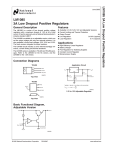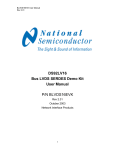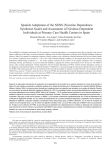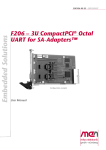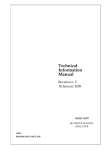Download Application Note 1376 External Serial Interface Reduces
Transcript
National Semiconductor Application Note 1376 Lee Sledjeski April 2005 1.0 Introduction FPGA allows the FPGA I/O to be programmed at the minimum CMOS drive level of about 2 mA. Reducing the drive level lowers the dynamic currents within the FPGA curbing the generation of SSO noise. Noise generated in the I/Os on a FPGA can corrupt the analog performance of FPGA PLLs or other system analog resources. The Altera Cyclone or Xilinx Spartan are good examples of economical FPGAs intended for low to medium end applications. They do not contain dedicated serialization or deserialization circuitry for high-speed communications limiting the maximum data rate. This makes the Cyclone and Spartan good candidates for an external serial interface. Using a SerDes external to an FPGA allows an entire multi-byte parallel interface to be condensed to one or more highspeed signal pairs for economical transmission across system interfaces. Before and after measurements of the SSO noise on a Cyclone FPGA will help to quantify the improvements made by the change in the FPGA programmed I/O current drive. A critical issue with any FPGA (Field Programmable Gate Array) design is Simultaneous Switching Output (SSO) noise. SSO noise, also known as ground bounce, is a result of large instantaneous changes in current across the power/ ground inductance of the integrated circuit. This potential problem becomes more and more serious as the number of active high-drive LVCMOS outputs on a FPGA design increases. In large FPGAs with several synchronous parallel interfaces this phenomenon can result in poor system performance or intermittent data errors. This application note highlights how using external SerDes in conjunction with minimum current drive FPGA I/O can reduce FPGA’s internal noise and reap the benefits of a serial interface across the system. This may allow designers to use low end FPGAs with external SerDes to reduce cost and still have high analog performance. The FPGA SSO noise is minimized by using the lowest drive current from the FPGA and reduces the parallel bus to a single differential signal. LVCMOS outputs from the FPGA are unsuited for driving over long interconnects or at high data rates. Upgrading the parallel interfaces with an external Serializer/Deserializer (SerDes) interface to the FPGA will reduce SSO noise and improve the overall system performance. The close proximity of the external SerDes to the 2.0 Test Setup for Simultaneous Switching Output Noise The FPGA/SerDes evaluation test setup is shown in Figure 1. 20146101 FIGURE 1. DS92LV16 SerDes and Cyclone FPGA Test Setup © 2005 National Semiconductor Corporation AN201461 www.national.com AN-1376 External Serial Interface Reduces Simultaneous Switching Output Noise in FPGAs AN-1376 External Serial Interface Reduces Simultaneous Switching Output Noise in FPGAs AN-1376 2.0 Test Setup for Simultaneous Switching Output Noise (Continued) used for the interface would depend upon the device selected, additional required functionality, and other layout constraints. For the best and most consistent AC performance, all the FPGA — SerDes interconnects should be selected from a single I/O bank. 2.1 TEST SETUP SCHEMATIC Figure 2 shows an example of a system implementation using the Cyclone and DS92LV16. The specific Cyclone I/Os 20146102 FIGURE 2. Cyclone and DS92LV16 Connections www.national.com 2 also contains loop back test capability for testing line and local interfaces. The Serializer and Deserializer operate independently with separate clock, enable, and power down pins. 2.2 COMPONENT INFORMATION 2.2.2 Altera Cyclone FPGA Table 1 shows the Cyclone device family and features. After selecting an FPGA to handle the logic and processing requirements of the application, the designer may chose to add an external SerDes due to system interface requirements. The FPGA choice depends on the end application requirements; the DS92LV16 can be effectively used with any FPGA density or architecture. 2.2.1 National DS92LV16 SerDes Figure 3 shows the block diagram for the DS92LV16 SerDes. The serializer takes 16-bits of parallel LVCMOS data and translates it into a serial stream with embedded clock. The serial data stream is output as a Low Voltage Differential Signaling (LVDS) signal with a maximum speed of 1.44 Gbps across cables or backplanes. The deserializer takes the differential LVDS signal and translates it back into 16-bit parallel LVCMOS data. The device 20146103 FIGURE 3. DS92LV16 Block Diagram TABLE 1. Device Features Feature LEs M4K RAM Blocks (128 x 36 bits) Total RAM Bits PLLs Maximum User I/O Pins EP1C3 EP1C4 EP1C6 EP1C12 EP1C20 2,910 4,000 5,980 12,060 20,060 13 17 20 52 64 59,904 78,336 92,160 239,616 294,912 1 2 2 2 2 104 301 185 249 301 The following test was conducted with the FPGA to DS92LV16 parallel bus clocking at 80 MHz and the LVCMOS output drive current of the FPGA set to either 24 mA or 2 mA. This will allow for the observation of SSO noise and other noise related effects on the parallel bus. 1. Simultaneous Switching Outputs — Switched 16 FPGA outputs simultaneously while monitoring a “quiet output” for ground bounce on the FPGA evaluation board. 3.0 Simultaneous Switching Output Noise SSO noise, as the name implies, is the result of internal and external circuitry switching at the same time. The cumulative effect of all this switching current passing through power and ground inductance is device-generated noise. This noise is visible on non-switching outputs as internal movement in the ground or power network. 3 www.national.com AN-1376 2.0 Test Setup for Simultaneous Switching Output Noise (Continued) AN-1376 3.0 Simultaneous Switching Output Noise (Continued) 2. Figure 4 shows the level of noise that can result from only 16 LVCMOS I/Os switching at the same time. Clock Output Jitter — Switched 16 FPGA outputs simultaneously while monitoring a FPGA clock output for jitter. 20146105 FIGURE 4. Active Output Transitions and “Quiet Output” (bottom), SS Data, 24 mA voltage of switching logic. The dynamic shift in supply voltage will cause changes in the switching characteristics of internal signals and reduce the performance of other more sensitive analog circuitry. In addition, the output signal also shows ringing and undershoots. The upper waveform (CH1) is the active switching transition repeated on 15 additional LVCMOS FPGA outputs driven at 24 mA. There is a visible 600 mV undershoot present just after the waveform falling edge. As expected, the bottom “quiet output” waveform (CH2) tends to follow this pattern highlighting an internal ground movement of ± 500 mV around the true board ground. This internal noise in the ground and power systems can dynamically alter the supply 20146106 FIGURE 5. Active Output Transitions and “Quiet Output” (bottom), SS Data, 2 mA Figure 5 shows the quiet and switching waveforms with the FPGA programmed for 2 mA (minimum) current drive. The upper waveform (CH1) is the active switching transition repeated on 15 additional LVCMOS FPGA outputs. Compared to the previous waveform, the 2 mA drive current results in www.national.com slower transition times and greatly reduced undershoot relative to external ground. Monitoring the signal on a quiet output (CH2) shows the improvement on the internal ground as well. 4 PLL analog performance. In addition to the reduction in FPGA performance, analog devices located adjacent to the FPGA will also be affected by the increase in ground noise. The following series of waveforms (Figure 6) show how a reduction in drive strength can improve the signal integrity and lower the jitter seen on FPGA output signals. The FPGA drive current reduction improves the signal integrity and lowers the jitter of output Clock signals. The noise on the clock signal is another indication of diminished FPGA 20146108 20146107 Reducing the FPGA programmed drive to 2 mA results in a tightly controlled clock waveform. With 24 mA of drive programmed into the FPGA outputs, large excursions outside the supply rails are clearly visible. 20146110 20146109 Rising Edge Magnification: This view shows how a reduced 2 mA drive current maintains good signal integrity and exceptionally low (∼50 ps) jitter. Rising Edge Magnification: This view shows greater than 200 ps of clock jitter in the FPGA output that is a result of the increased drive current. FIGURE 6. 24 mA Drive vs 2 mA Drive for FPGA Output Clock Signal Integrity and Jitter The reduction in jitter will improve analog performance of adjacent components like the DS92LV16. Starting with a clean clock source means that significantly reduced jitter within the PLL bandwidth will allow for enhanced high-speed signal integrity. By reducing the FPGA interconnect to short-to-point topology, the low drive (2 mA) setting can efficiently and cleanly drive the LVCMOS interconnect into the LVDS SerDes. Programming to the low drive setting reduces the noise generated by the FPGA and reduces system EMI. Figure 7 and 5 www.national.com AN-1376 3.0 Simultaneous Switching Output Noise (Continued) AN-1376 3.0 Simultaneous Switching Output Noise (Continued) 4.1 External SerDes Reliability The main function of any SerDes chipset is to translate data originating from a wide parallel bus into one or more serial bit streams and to convert the data back a wide parallel bus at the receiving end. With the system improvements SerDes devices bring, one of the first questions system designers may ask is how long the interconnect between the serializer and the deserializer can be that will still ensure error-free data transfer. Figure 8 clearly show undershoot and overshoot is completely eliminated and noise reduction achieved with low drive FPGA programming. To find out the answers to questions of “How far?” and “How fast?” a type of testing called BER or Bit Error Rate Testing is done on the serial interface. Figure 9 shows the eye diagram at the DS92LV16 receiver after 1m of CAT5 cable. This diagram shows the wide open eye possible with inexpensive CAT5 cable running at a data rate of almost 1 Gbps. The maximum data rate of the DS92LV16 is approximately 1.5 Gbps. 20146111 FIGURE 7. 24 mA FPGA Output +4" Trace with PRBS Data 20146114 FIGURE 9. Eye Diagram after 1m of CAT5 Cable A related example of this type of testing is shown below. As depicted in Figure 10, a BER transmitter provided 18-bit wide PRBS (215-1) and a BER receiver received 18-bit wide PRBS (215-1). The DS92LV18 transmitter serialized the sequence and sent it across a cable assembly; the DS92LV18 receiver then de-serialized the data, and sent the 18-bit wide PRBS pattern back to the BERT for analysis. Configuring the test setup in this manner allows the maximum operating frequency to be determined for each cable length. The maximum operating frequency of this system is defined as the maximum frequency of the device transmitter clock (TCLK) at which the device receiver misinterprets zero out of 1012 data bits. This equates to the bit error rate of less than 1 x 10−12. The test was conducted at room temperature and the power supply voltage for both devices was set to 3.3 volts. For a DS92LV18 SerDes the TCLK frequency equates to 1/20th of the high-speed serial data rate. For example, at the chipset maximum TCLK of 66MHz the serial data rate is running at a speed of 1.32Gbps. 20146112 FIGURE 8. 2 mA FPGA Output +4" Trace with PRBS Data 4.0 Benefits of Using External SerDes LVCMOS outputs from the FPGA are unsuited for driving over long interconnects or at high data rates. To address these system demands and to reduce the number of signals at backplane or cable interfaces, SerDes devices with low voltage differential signaling (LVDS) technology are often employed. www.national.com 6 AN-1376 4.0 Benefits of Using External SerDes (Continued) 20146115 FIGURE 10. DS92LV18 SerDes BER Test Setup Based on the BERT results, the DS92LV18 can be used in short to medium length cable interface applications. If employed to move data between two points across a generic category 5 cable, it can operate at its highest operating frequency (66 MHz) for cable lengths up to 10 feet. For lower operating frequencies, it can transmit error free data over cables longer than 50 feet. Shielded cables with lower nominal attenuation paired with connectors rated for gigabit operation enable you to make longer high-speed, error free connections. Even though the speeds have increased dramatically, the serial interface can transfer data at a rate and distance just not possible with a parallel interface. In order to accommodate Gigabytes of data 32, 64, or even 128-bit parallel bus designs have been implemented. This resulted in massive routing bottlenecks at cable assemblies, memory board, and backplane interfaces. These performance-limiting issues were addressed when the parallel interfaces were replaced with one or more high-speed serial interfaces. This architecture shift has enabled system performance, packaging, and features that could not otherwise have been achieved. 4.2 External SerDes With Pre-Emphasis Feature Even at the lower data rates used in parallel architectures, a factor limiting transmission distance has always been the electrical losses of the transmission media. Serial architectures have progressed to address the dielectric and skin effect loss issues associated with high-speed design in several ways. In order to achieve high-speed reliable data transmission across cables up to 50 feet long something must be done to compensate for the high frequency loss in the cable. Pre-emphasis is a circuit design technique that adds high frequency energy to the transmitter output signal, negating the loss incurred during data transmission across the medium. The National Semiconductor SCAN921821, a dual 18-bit Serializer, uses 6 dB of pre-emphasis to maintain robust, error-free communication across 50 feet of cable. This added feature increases the reach of LVDS SerDes by up to 5x at > 1 Gbps serial data rates. 7 www.national.com AN-1376 4.0 Benefits of Using External SerDes (Continued) 20146116 Measured after 15m of Infiniband Cable at the Input of the DS92LV18 Receiver; fTCLK = 66 MHz (1.32 Gbps); No Pre-emphasis FIGURE 11. Eye Diagram measured after 15m of Infiniband Cable at the Input of the DS92LV18 Receiver; fTCLK = 66 MHz (1.32 Gbps); No Pre-emphasis www.national.com 8 AN-1376 4.0 Benefits of Using External SerDes (Continued) 20146117 Measured after 15m of Infiniband Cable at the Input of the DS92LV18 Receiver; fTCLK = 66 MHz (1.32 Gbps); Max Pre-emphasis FIGURE 12. Eye Diagram measured after 15m of Infiniband Cable at the Input of the DS92LV18 Receiver; fTCLK = 66 MHz (1.32 Gbps); Max Pre-emphasis The eye diagrams shown in Figure 11 and Figure 12 clearly show the value of pre-emphasis for driving cables up to 15 to 20 meters in length. A SCAN921821 Dual 18-bit Serializer is transmiting the data while a DS92LV18 SerDes is receiving the data. 5.1 RESOURCES AND REFERENCES 1. DS92LV16 Design Guide, National Semiconductor, October 2002, www.national.com 2. DS92LV16 Bus LVDS SerDes Demo Kit User Manual, National Semiconductor, October 2003, www.national.com 3. LVDS Owner’s Manual, National Semiconductor, 3rd Edition, Spring 2004, www.national.com 4. Cyclone Device Handbook Volumes 1 & 2, Altera, 2003 and 2004, www.altera.com 5. Quartus II Handbook Volumes 1, 2 & 3, Altera, 2004, www.altera.com 6. DS92LV16 16-Bit Bus LVDS Serializer/Deserializer Datasheet, National Semiconductor, 2004, www.national.com 7. DS92LV18 18-Bit Bus LVDS Serializer/Deserializer Datasheet, National Semiconductor, 2004, www.national.com 8. SCAN921821 Bus LVDS Dual 18-Bit Serializer Demo Kit User Manual, National Semiconductor, 2004, www.national.com 9. DS92LV16 Bus LVDS SerDes Demo Kit User Manual, National Semiconductor, October 2003, www.national.com 5.0 Conclusion Using a stand alone SerDes is an effective way to minimize device generated SSO noise in the FPGAs. The external SerDes device allows the used to program the FPGA with a minimum output drive. The minimum drive limits the noise generated by the FPGA due to reduced simultaneous switching currents. Reduced noise lowers the risk that adjacent analog components will become inadvertent victims of excessive digital noise. In addition to the local noise reduction benefits shown in the application note, Using a stand alone SerDes function provides lower jitter, BER and longer drive capability resulting in better analog performance. External SerDes function may also allow lower cost solutions with performances comparable to the higher cost solutions. Analog enhancements, such as pre-emphasis, have enabled even higher speeds and longer drive distances over lossy interconnect. This capability, achieved though low cost silicon upgrades can be used to extend the operational life and enhance the functionality of systems currently deployed in the field. 9 www.national.com AN-1376 External Serial Interface Reduces Simultaneous Switching Output Noise in FPGAs Notes National does not assume any responsibility for use of any circuitry described, no circuit patent licenses are implied and National reserves the right at any time without notice to change said circuitry and specifications. For the most current product information visit us at www.national.com. LIFE SUPPORT POLICY NATIONAL’S PRODUCTS ARE NOT AUTHORIZED FOR USE AS CRITICAL COMPONENTS IN LIFE SUPPORT DEVICES OR SYSTEMS WITHOUT THE EXPRESS WRITTEN APPROVAL OF THE PRESIDENT AND GENERAL COUNSEL OF NATIONAL SEMICONDUCTOR CORPORATION. As used herein: 1. Life support devices or systems are devices or systems which, (a) are intended for surgical implant into the body, or (b) support or sustain life, and whose failure to perform when properly used in accordance with instructions for use provided in the labeling, can be reasonably expected to result in a significant injury to the user. 2. A critical component is any component of a life support device or system whose failure to perform can be reasonably expected to cause the failure of the life support device or system, or to affect its safety or effectiveness. BANNED SUBSTANCE COMPLIANCE AN-1376 National Semiconductor manufactures products and uses packing materials that meet the provisions of the Customer Products Stewardship Specification (CSP-9-111C2) and the Banned Substances and Materials of Interest Specification (CSP-9-111S2) and contain no ‘‘Banned Substances’’ as defined in CSP-9-111S2. National Semiconductor Americas Customer Support Center Email: [email protected] Tel: 1-800-272-9959 www.national.com National Semiconductor Europe Customer Support Center Fax: +49 (0) 180-530 85 86 Email: [email protected] Deutsch Tel: +49 (0) 69 9508 6208 English Tel: +44 (0) 870 24 0 2171 Français Tel: +33 (0) 1 41 91 8790 National Semiconductor Asia Pacific Customer Support Center Email: [email protected] National Semiconductor Japan Customer Support Center Fax: 81-3-5639-7507 Email: [email protected] Tel: 81-3-5639-7560












